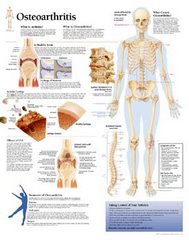What is it?
Osteoarthritis is a type of arthritis that is caused by the breakdown and eventual loss of the cartilage of one or more joints. Osteoarthritis is also known as degenerative arthritis. Among the over 100 different types of arthritis conditions, osteoarthritis is the most common, affecting over 20 million people in the United States. Osteoarthritis occurs more frequently as we age. Osteoarthritis commonly affects the hands, feet, spine, and large weight-bearing joints, such as the hips and knees.
What causes it?
There are 2 types of osteoarthritis:
1. Primary osteoarthritis is mostly related to aging. Repetitive use of the joints over the years irritates and inflames the cartilage, causing joint pain and swelling. In advanced cases, there is a total loss of the cartilage cushion between the bones of the joints. The loss of the cartilage cushion causes friction between the bones, leading to pain and limited mobility. Inflammation of the cartilage can also cause bone spurs around the joint. Osteoarthritis can sometimes be found in members of the same family which means there may be a genetic component for this condition.
2. Secondary osteoarthritis is caused by another disease or condition. Conditions that can lead to secondary osteoarthritis include obesity, repeated trauma or surgery to the joint structures, congenital abnormalities, gout, diabetes and other hormone disorders.
Treatment and prevention
Aside from weight reduction and avoiding activities that exert excessive stress on the joint cartilage, there is no specific treatment to stop the cartilage degeneration or to repair damaged cartilage in osteoarthritis. The goal of treatment in osteoarthritis is to reduce joint pain and inflammation while improving and maintaining joint function. Some patients with osteoarthritis have minimal or no pain, and may not need treatment. Others benefit from conservative measures such as rest, exercise, weight reduction, physical and occupational therapy, and mechanical support devices. These measures are particularly important when large, weight-bearing joints are involved, such as the hips or knees. Medications are used to help with inflammation and pain. Medication may be used topically, taken orally, or injected into the joints to decrease joint inflammation and pain. When all other methods fail to control the pain and improve joint mobility, surgery is condidered.Exercise can help reduce joint pain and stiffness. Light- to moderate-intensity physical activity may help to restore health and function. However, some people with osteoarthritis may be reluctant to exercise because of joint pain after activity. Various steps can be taken to help relieve pain, such as heat and cold therapy or taking pain relievers, which may make it easier for you to exercise and stay active. Choose partial or non-weight bearing exercise, such as bicycling, swimming, or water exercise.
Massage and Osteoarthritis
Massage therapy can help reduce pain and improve function in people suffering from osteoarthritis. Treatment goals include reducing stiffness pain, edema and spasm, increasing range of motion and reducing inflammation. Deep pressure massage and joint mobilizations should be avoided because these movements may injure the client. Communication about the depth of pressure at the site of arthritis is essential so as to not cause any discomfort. Techniques that can be helpful are gliding strokes, light kneading, light vibration, and superficial warming friction, within the clients tolerance, which can warm and loosen surrounding tissues.Some self care for the client may include hydrotherapy, such as deep moist heat for chronic pain and soreness, or cold for acute episodes. Self-massage is also good for the surrounding muscles of the affected joint. Relaxation techniques such as diaphragmatic breathing are also helpful. Gentle pain free stretching and range of motion are important in strengthing the muscles and alleviate some pain.
Clinical Massage Therapy, Copyright Rattray and Ludwig, 2000
Mosby's Pathology for Massage Therapists, 2004, Mosby, Inc.
|
